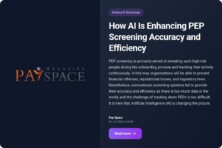Artificial intelligence is slowly but steadily penetrating into every sphere of business activities and consumer services. It seems that AI is the future of automation technology in finance as well. Consumer lending is one of the banking segments that can reap most of the benefits of AI automation.

The word ‘AI’ was uttered multiple times at the flagship tech conference CES 2024 held in Las Vegas this January. Every tech giant is either developing their own AI tools or employing existing solutions in an innovative way. Often, they go both ways just to make sure they’re not lagging behind their skillful competitors. Well, the world’s tech leaders must know what they’re doing, grabbing every opportunity to leverage AI’s vast potential.
What about fintech? The financial technologies don’t shy away from AI experiments as well. Starting from ‘smart’ internal and customer support chatbots to identifying sophisticated cybersecurity dangers, AI has been extremely helpful to fintech professionals at every operation stage. At the same time, its potential for consumer lending automation has not been fully realised just yet.
What Is Consumer Lending?
Consumer lending is a broad all-encompassing term that describes providing individuals with fixed loans or credit amounts, to help them cover personal financial needs. This type of lending is the opposite of business or corporate lending, focusing on commercial money use. Consumer lending includes the following financial products and services:
- Personal Loans: Unsecured loans dedicated to various purposes, such as debt consolidation, home improvements, or emergency expenses.
- Auto Loans: Money borrowed for the purchase of vehicles, whereas the vehicle itself may serve as loan collateral.
- Credit Cards: Revolving lines of credit enabling consumers to make daily purchases up to a set limit and repay the borrowed amount over time. Typically, interest is charged on the outstanding balance every month, though there’s a certain grace period when additional interest doesn’t apply.
- Mortgages: Loans specifically aimed at buying real estate, where the property itself serves as collateral. Mortgage loans are usually long-term ones, with fixed or variable interest rates.
- Student Loans: Loans intended to help students finance their education. They often have deferred repayment options allowing borrowers to complete their education before repaying the borrowed amount.
- Payday Loans: Short-term, high-interest loans typically intended to cover unexpected expenses of a person with a stable income source. These loans are repaid from the borrower’s next paycheque.
- Instalment Loans: Loans repaid in fixed, regular instalments over a predetermined period. These may include personal loans, auto loans, and certain types of furniture or appliance financing.
- BNPL: Buy Now Pay Later credit is a type of short-term instalment loan that doesn’t involve charging interest if the borrower pays instalments on time.
How AI Can Automate Consumer Lending
Consumer lending has a few areas of potential automation. Here are several processes that can be streamlined with the help of AI and other advanced technologies to reduce time and effort of the financial institution’s employees, increase efficiency and boost productivity.
Online Application and Approval
- Digital Platforms: Lenders may develop user-friendly online platforms and mobile applications where borrowers can submit loan applications 24/7 without excessive paperwork. These platforms can employ AI technology to personalise loan offers, answer questions, and give some loan tips.
- Automated Decision-Making: AI algorithms can quickly process and analyse applicant information, including credit scores, income, and other relevant factors, to make quick and consistent lending decisions and access credit risks.
Data Analysis and Credit Scoring
- Machine Learning Models: Emerging sophisticated machine learning models are able to analyse a wide range of data points and predict creditworthiness. Their capabilities and speed grow daily.
- Alternative Data Sources: Incorporating non-traditional data sources, such as social media activity, purchase history, or utility payment history can enhance credit scoring accuracy. AI algorithms easily pool data from various sources to make an all-round picture of a borrower’s credit profile.
KYC (Know Your Customer) and Identity Verification
- Biometric Authentication: Utilising biometric data (fingerprint, facial recognition) is the new norm in secure and efficient identity verification. AI technology can also help firms employ behavioural biometrics, analysing customers’ activity patterns, keystroke dynamics, and other physical and behavioural peculiarities to improve fraud prevention techniques.
- Document Verification: Employing optical character recognition (OCR) and AI automates verification and analysis of the official documents submitted by applicants. With AI’s ability to quickly confirm borrowers’ information, loan applications can be approved in a matter of minutes, giving customers quick access to much-needed finances.
Loan Underwriting
- Automated Underwriting Systems (AUS): AUS systems automatically assess risk and determine the terms of the loan based on predefined criteria. Some of them incorporate social media data to gain additional insights into an applicant’s behaviour and financial stability. The systems also leverage predictive analytics to identify trends and patterns in an applicant’s financial behaviour, helping lenders make more informed decisions. In all these cases, machine learning algorithms take care of the data analysis, improving their accuracy over time.
- Rule-Based Engines: Rule-based engines can be used to automate a lender’s decision-making based on specific lending policies and regulations. AI and deep learning can be integrated into rule-based engines to assess and predict risks, handle intricate rule structures, optimise rule sets, interpret and analyse unstructured data, automatically generate rules based on patterns discovered in large datasets, and continuously improve decision rules.
Document Management
- Document Classification: While OCR Technology helps extract relevant information from documents, reducing the need for manual data entry, AI automatically categorises and organises documents submitted by applicants, providing basic analysis of extracted data.
Loan Servicing and Monitoring
- Automated Repayment Systems: Human employees shouldn’t bother with manually checking numerous individual loan repayment terms, if lenders can easily set up automated systems for loan repayments, including direct debits, with timely reminders.
- Monitoring Systems: An organisation can implement AI-powered systems that continuously monitor borrower spending behaviour and financial status to detect early signs of repayment difficulties and possibly offer assistance or flexible terms.
Customer Communication
- Chatbots and Virtual Assistants: Most financial institutions and e-commerce players offering BNPL and instalment options are already using AI-powered chatbots to handle customer enquiries, provide information, and assist with the loan application process.
- Transparency of Decision-Making: With the rise of explainable AI, both internal and customer-oriented chatbots may provide certain insights into how credit decisions are made. This transparency is essential for regulatory compliance and gaining user trust. Moreover, they can hint at areas customers should focus on to improve their creditworthiness.
- Automated Notifications: Sending automated notifications to borrowers regarding payment due dates, account statements, and other relevant information enhances the chances of being repaid. At the same time, recent research has shown that the impact of various nudge message forms varies depending on the borrower’s income status. AI use can help banks and fintechs experiment with their payment reminders and customise them for different customer segments to reduce delinquencies and defaults.
Fraud Detection
- Behavioural Analytics: Employing AI algorithms to analyse user behaviour and identify patterns indicative of fraudulent activity greatly enhances the level of an organisation’s cybersecurity and reduces financial losses. Fraud detection engines enhanced with AI can process and analyse more data in real-time, allowing for quick and efficient preventive measures.
- Anomaly Detection: AI is capable of automatically flagging and investigating unusual or suspicious transactions. Adding the analysis of behavioural biometrics and other factors enables anomaly detection algorithms to identify irregular patterns or behaviour that may indicate fraudulent activity, adding an extra layer of security to the underwriting process.
Consumer lending plays a crucial role in providing financial support to individuals in achieving their financial goals and boosting the consumers’ purchasing capability. The use of advanced technology such as AI can help mitigate loan risks for both borrowers and lenders. Lenders can automate various processes across their business ecosystem, including fraud detection, communication with customers, loan underwriting, application analysis, document management, decision-making, KYC, credit scoring and more.
While traditional lenders assess factors such as credit history, income, and debt-to-income ratio to determine the borrower’s creditworthiness and the terms of the loan, the implementation of AI helps take into account additional factors such as e-commerce and offline purchases, utility payment history, and even social media activity to increase the accuracy of repayment forecasts and expand the pool of potential borrowers.









